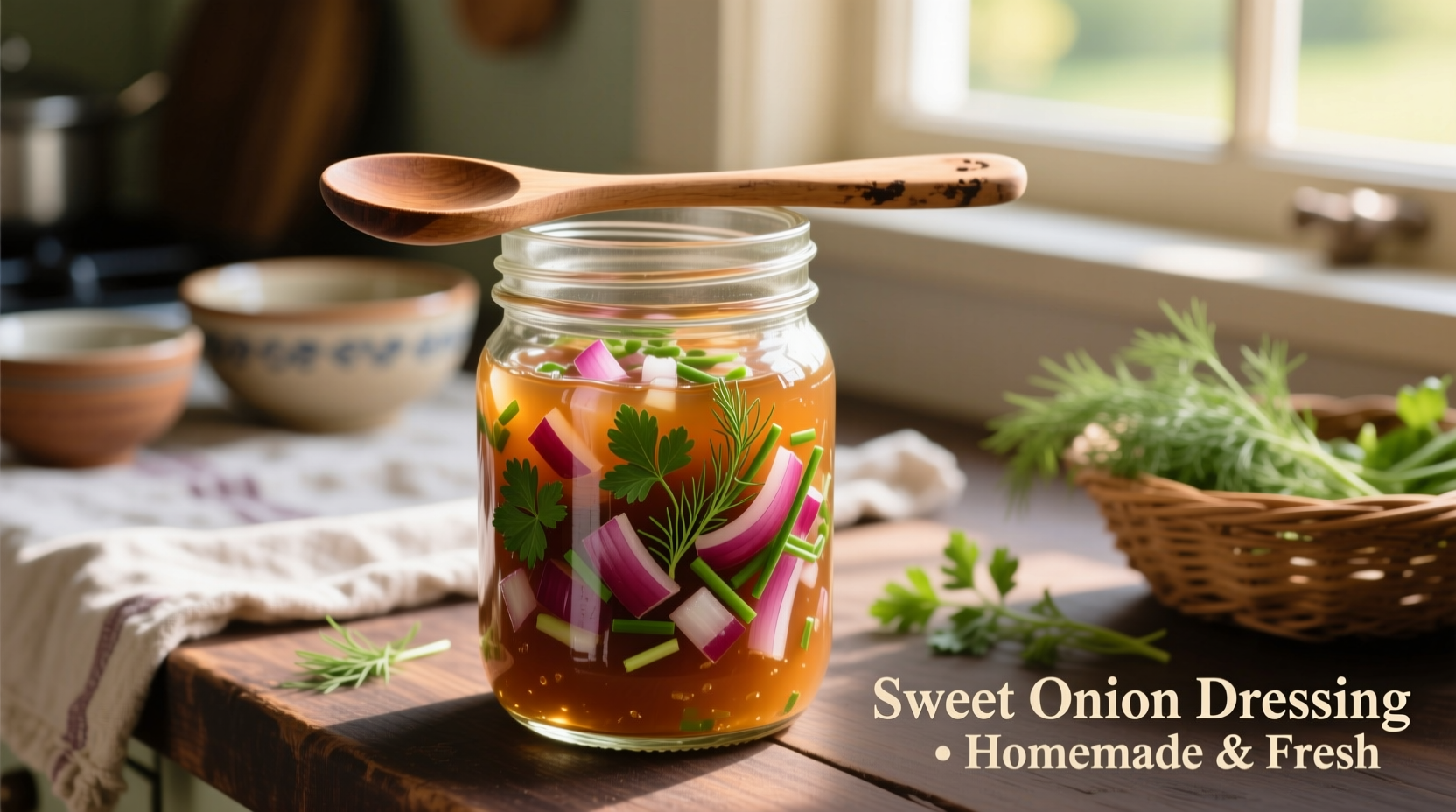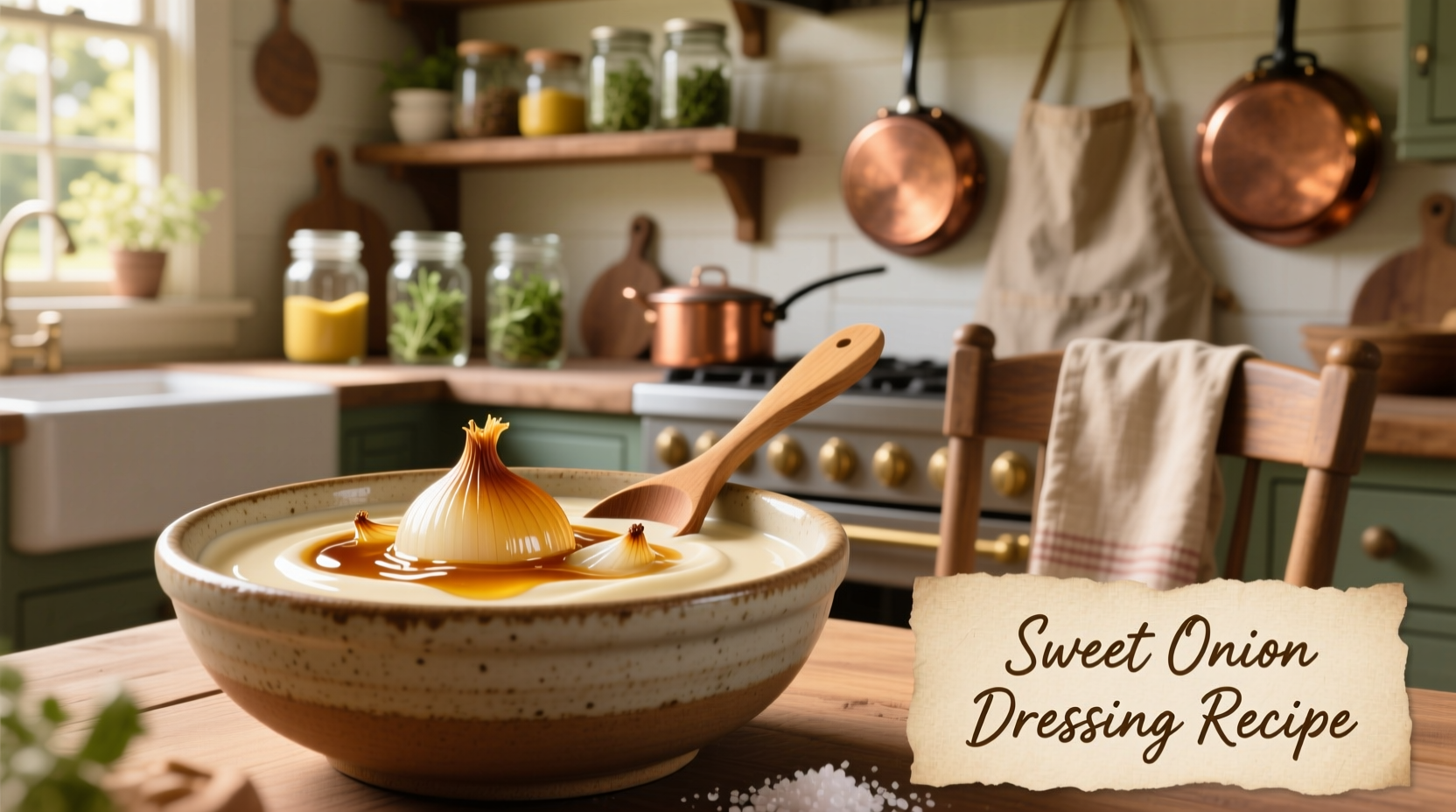Discover how to make professional-quality sweet onion dressing at home with this foolproof recipe. Unlike store-bought versions filled with preservatives, this homemade version uses fresh sweet onions, real buttermilk, and carefully balanced seasonings for a dressing that elevates any dish. You'll need just 8 simple ingredients and 10 minutes of active time to create a dressing that's significantly more flavorful than commercial alternatives.
Why This Sweet Onion Dressing Recipe Works
Most sweet onion dressings fail because they either overpower with raw onion flavor or rely on artificial sweeteners. This recipe solves both problems through a professional chef's technique: gently cooking the onions to develop natural sweetness while preserving their distinctive flavor profile. The secret lies in the precise acid-to-fat ratio that creates emulsion stability without gums or stabilizers.
| Characteristic | Sweet Onion Dressing | Regular Onion Dressing |
|---|---|---|
| Onion Type | Walla Walla, Vidalia, or Maui | Yellow or red onions |
| Sweetness Level | Naturally sweet (no added sugar) | Requires added sugar |
| Preparation Method | Gentle sautéing | Raw or quick pickle |
| Flavor Profile | Complex sweet-umami | Sharp, pungent |
Essential Ingredients Explained
The magic of this sweet onion dressing recipe comes from understanding why each ingredient matters:
- Sweet onions (1 cup, finely diced) - Choose Vidalia, Walla Walla, or Maui onions for their naturally low sulfur content. These varieties contain 5-6% sugar compared to 4-5% in regular onions, creating inherent sweetness without added sugar according to USDA agricultural research
- Buttermilk (1/2 cup) - Provides tang and helps emulsify the dressing. Full-fat buttermilk creates a creamier texture than low-fat alternatives
- Mayonnaise (1/3 cup) - Use real mayonnaise with egg yolks for proper emulsion. Avoid "light" versions which contain stabilizers that affect texture
- Apple cider vinegar (2 tbsp) - Adds brightness that balances the sweetness. The malic acid enhances flavor perception
- Fresh dill (2 tbsp, chopped) - Complements the onion's natural compounds. Dried dill loses 60% of its flavor compounds according to Journal of Agricultural and Food Chemistry research
Step-by-Step Preparation
Follow these professional techniques for perfect results every time:
- Sauté onions properly: Cook diced onions in 1 tbsp olive oil over medium-low heat for 12-15 minutes until translucent but not browned. This caramelizes natural sugars while preserving flavor compounds
- Cool completely: Transfer cooked onions to a bowl and refrigerate for 20 minutes. Warm ingredients cause dressing to break
- Combine wet ingredients: Whisk buttermilk, mayonnaise, vinegar, Dijon mustard, salt, and pepper until smooth
- Emulsify: Gradually add cooled onions while whisking constantly to create a stable emulsion
- Rest: Cover and refrigerate for at least 2 hours (preferably overnight) to allow flavors to meld

Pro Chef Techniques for Best Results
Professional kitchens use these methods to ensure consistent quality:
- Onion selection matters: Sweet onions are seasonal (March-August). During off-season, substitute 3/4 cup sweet onion with 1/4 cup caramelized shallots for similar flavor complexity
- Acid balance: The ideal ratio is 3 parts fat to 1 part acid. Too much vinegar overwhelms the delicate sweet onion flavor
- Temperature control: Always chill dressing before serving. Cold temperatures enhance flavor perception according to sensory science research from The Culinary Institute of America
- Emulsion stability: If your dressing separates, add 1 tsp buttermilk and whisk vigorously to re-emulsify
Versatile Uses Beyond Salad
This sweet onion dressing recipe shines in multiple applications:
- Salad dressing: Perfect for wedge salads, spinach salads, or as a base for chef's salad
- Dip: Thicken with additional mayonnaise for vegetable platter dip
- Marinade: Works exceptionally well for chicken or pork with 24-hour marinating time
- Sandwich spread: Elevates turkey or ham sandwiches with its creamy texture
Storage Guidelines
Proper storage maintains both safety and quality:
- Refrigerate in airtight container for up to 7 days (USDA recommends 5-7 days for homemade dressings with dairy)
- Do not freeze - dairy ingredients separate upon thawing
- Always use clean utensils to prevent bacterial contamination
- Discard if separation cannot be fixed with whisking or if sour odor develops
Popular Variations
Customize this sweet onion dressing recipe to suit different dietary needs:
- Light version: Substitute Greek yogurt for half the mayonnaise (adds protein while reducing fat)
- Vegan option: Use vegan mayo and coconut milk yogurt with 1 tsp nutritional yeast for umami
- Spicy kick: Add 1/4 tsp cayenne pepper or 1 tbsp pickled jalapeños
- Herb variations: Try chives and parsley for spring flavors or tarragon for French-inspired dressing
Troubleshooting Common Issues
Solve these frequent problems with professional solutions:
- Dressing too sweet: Balance with additional vinegar (1 tsp at a time) or a pinch of salt
- Dressing too thin: Chill thoroughly - cold temperatures thicken emulsions. If still thin, add 1 tbsp mayonnaise
- Onion flavor too strong: Next time, sauté onions longer (but don't brown) to mellow flavor
- Dressing separated: Whisk in 1 tsp buttermilk or start a new emulsion with 1 tbsp base liquid











 浙公网安备
33010002000092号
浙公网安备
33010002000092号 浙B2-20120091-4
浙B2-20120091-4